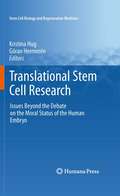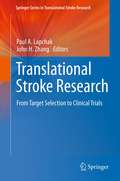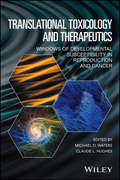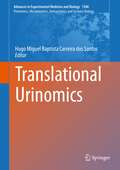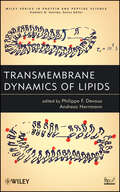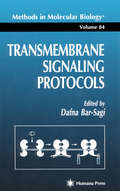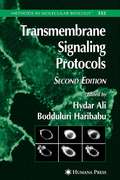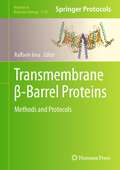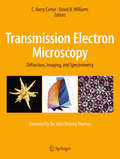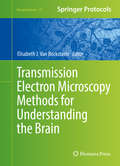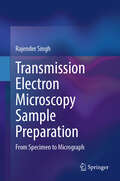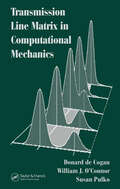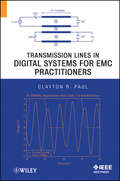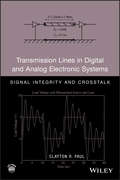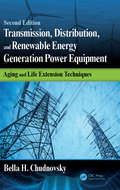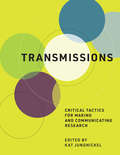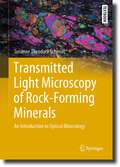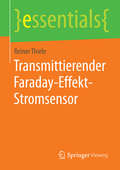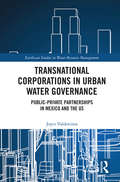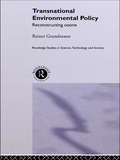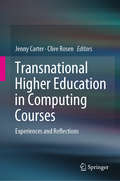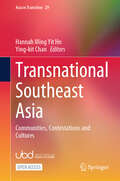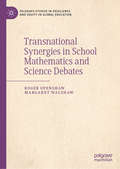- Table View
- List View
Translational Stem Cell Research
by Göran Hermerén Kristina HugFor many years, the ethical discussion surrounding human embryonic stem cell research has focused on the moral status of the embryo. This text takes a wider moral berth and focuses on numerous ethical, legal and social aspects involved in translating the results of stem cell research into diagnostic and therapeutic applications. Translational Stem Cell Research is broken into ten sections. It opens with an overview of the latest in stem cell research, focusing on specific diseases and the treatment of burn victims. Part II discusses the issues involved in the many steps from bench to bedside, ranging from first research in vitro to clinical trials. Part III covers scientific, regulatory and ethical challenges to basic research, and Part IV details issues regarding stem cell banks. Part V explores ethical, economic and strategic issues involved in collaboration between universities and industry, and Part VI addresses legal problems raised by patents on human stem-cell based inventions plus the extent to which there can be technological solutions to a moral dilemma. Part VII presents imaginative ways of communicating research to the general public and how to create conditions for a constructive dialogue. Part VIII probes psychosocial and cultural factors affecting judgment and decisions about translational stem cell research, and Part IX explores problems and procedures raised by an examination of the evaluation of stem cell research projects in research ethics committees. The book closes with a look into the future of translational stem cell research and stem cell-based therapeutic applications.
Translational Stroke Research
by Paul A. Lapchak John H. ZhangThis volume sets a basis for effective translational research. Authored by experts in the field of translational stroke research, each chapter specifically addresses one or more components of preclinical stroke research. The emphasis is placed on target identification and drug development using state-of-the-art in vitro and in vivo assays, in combination with in vitro toxicology assays, AMDE and clinical design.
Translational Toxicology and Therapeutics: Windows of Developmental Susceptibility in Reproduction and Cancer
by Claude L. Hughes Michael D. WatersWritten by leading research scientists, this book integrates current knowledge of toxicology and human health through coverage of environmental toxicants, genetic / epigenetic mechanisms, and carcinogenicity. Provides information on lifestyle choices that can reduce cancer risk Offers a systematic approach to identify mutagenic, developmental and reproductive toxicants Helps readers develop new animal models and tests to assess toxic impacts of mutation and cancer on human health Explains specific cellular and molecular targets of known toxicants operating through genetic and epigenetic mechanisms
Translational Urinomics (Advances in Experimental Medicine and Biology #1306)
by Hugo Miguel Baptista Carreira dos SantosTranslational Urinomics provides an overview of urine analysis using proteomics, metabolomics, transcriptomics or any combination thereof for the diagnosis and prognosis of diseases related to the urinary system and the kidneys. The text approaches urine biomarkers from a new perspective, incorporating up-to-date studies of mass-spectrometry-based biomarker discovery as well as the latest advances in personalized medicine. The integration of technology-driven techniques, such as OMICS also provides a unique opportunity for improved diagnostics accuracy of urinary-related diseases. For nephrologists and urologists looking for new approaches to well-known problems, this edited volume serves as a valuable guide.
Transmembrane Dynamics of Lipids (Wiley Series in Protein and Peptide Science #9)
by Andreas HerrmannThe first and only book devoted entirely to MEMBRANE LIPID ASYMMETRY AND ITS BIOLOGICAL IMPLICATIONS Transmembrane Dynamics of Lipids is comprised of contributions from expert authors from leading research groups that present up-to-date quantitative data on the formation, stability, and biological consequences of the asymmetrical organization of lipids in cell membranes. Incorporating an impressive amount of new, previously uncollected data, the book examines transmembrane asymmetry and movement of lipids in biological membranes, and methods for the measurement of transmembrane lipid motion, emphasizing the role of lipid flippases and discusses biological functions associated with lipid asymmetry. In addition, it draws attention to important new discoveries in the field, such as the correlation between malfunction of lipid flippases and human diseases such as thrombosis and cancer. The book also addresses the manifold methods that are used to measure the rate of transmembrane movement of lipids in biological and model systems. The only guide to new discoveries regarding lipids in cell membranes, Transmembrane Dynamics of Lipids is designed to appeal to biophysicists, biochemists, and cellular and molecular biologists working in the growing field of membrane research.
Transmembrane Signaling Protocols
by Dafna Bar-SagiThis collection of practical, cutting-edge techniques for the study of cell signaling provides detailed, step-by-step instructions, helpful notes, and troubleshooting tips that make even the most powerful of the newest techniques readily reproducible. The protocols presented include the use of peptide libraries to study transmembrane signaling; the use of single-cell assays to analyze signal transduction pathways; the reconstitution of signaling complexes; methods for analyzing protein-protein interactions, and more. Introductory reviews explain the basic theory and enable researchers new to the area to rapidly gain understanding, as well as command of the practical knowledge and expertise afforded by the protocols. Transmembrane Signaling Protocols makes available to all researchers the many state-of-the-art techniques that have recently led to landmark discoveries in transmembrane signaling.
Transmembrane Signaling Protocols
by Hydar Ali Haribabu BodduluriThis fully updated and expanded second edition of Transmembrane Signaling Protocols demonstrates the use of such techniques as single cell imaging, bioluminecence resonance energy transfer, and global proteomics in the study of transmembrane signaling events. Highlights include the functional expression and genetic selection of mutant mammalian transmembrane receptors in yeast, real-time analysis of transmembrane receptor signaling in live cells, and bioluminescence energy transfer to monitor protein-protein interaction. Additional chapters use state-of-the-art methods to analyze gene expression and proteomic profiles related to transmembrane signaling events, as well as to genetically reconstitute bone marrow for the study of signal transduction ex vivo. The protocols follow the successful Methods in Molecular BiologyTM series format, each offering step-by-step laboratory instructions, an introduction outlining the principles behind the technique, lists of the necessary equipment and reagents, and tips on troubleshooting and avoiding known pitfalls.
Transmembrane β-Barrel Proteins: Methods and Protocols (Methods in Molecular Biology #2778)
by Raffaele IevaThis detailed volume explores experimental strategies and protocols for the expression, assembly, characterization, and exploitation of transmembrane β-barrel proteins. Beginning with methodologies to study their assembly, the book continues with protocols for characterizing the landscape of transmembrane β-barrel protein interactions with other cellular factors, dissecting processes of protein transport in bacteria and mitochondria, examining structural characterization, determination, and prediction, and more. Written for the highly successful Methods in Molecular Biology series, chapters include introductions to their respective topics, lists of the necessary materials and reagents, step-by-step and readily reproducible laboratory protocols, and tips on troubleshooting and avoiding known pitfalls. Authoritative and practical, Transmembrane β-Barrel Proteins: Methods and Protocols serves as an ideal guide for researchers seeking to expand our knowledge of these vital membrane-spanning proteins.
Transmission Electron Microscopy
by C. Barry Carter David B. WilliamsThis text is a companion volume to Transmission Electron Microscopy: A Textbook for Materials Science by Williams and Carter. The aim is to extend the discussion of certain topics that are either rapidly changing at this time or that would benefit from more detailed discussion than space allowed in the primary text. World-renowned researchers have contributed chapters in their area of expertise, and the editors have carefully prepared these chapters to provide a uniform tone and treatment for this exciting material. The book features an unparalleled collection of color figures showcasing the quality and variety of chemical data that can be obtained from today's instruments, as well as key pitfalls to avoid. As with the previous TEM text, each chapter contains two sets of questions, one for self assessment and a second more suitable for homework assignments. Throughout the book, the style follows that of Williams & Carter even when the subject matter becomes challenging--the aim is always to make the topic understandable by first-year graduate students and others who are working in the field of Materials Science Topics covered include sources, in-situ experiments, electron diffraction, Digital Micrograph, waves and holography, focal-series reconstruction and direct methods, STEM and tomography, energy-filtered TEM (EFTEM) imaging, and spectrum imaging. The range and depth of material makes this companion volume essential reading for the budding microscopist and a key reference for practicing researchers using these and related techniques.
Transmission Electron Microscopy Methods for Understanding the Brain
by Elisabeth J. Van BockstaeleThis volume is directed at individuals interested in the field of neuroscience who are novices or experts in the use of transmission electron microscopy. The goal of is to provide a comprehensive series of chapters on how this tool can be used to study the brain with a strong emphasis on successful hands on application of the electron microscopy technique. Written in the popular Neuromethods series style, chapters include the kind of detail and key advice from the specialists needed to get successful results in your own laboratory. Concise and easy-to-use, Transmission Electron Microscopy Methods for Understanding the Brain aims to ensure successful results in the further study of this vital field. "
Transmission Electron Microscopy Sample Preparation: From Specimen to Micrograph
by Rajender SinghThis book is a thorough guide tailored for researchers, academics, and practitioners immersed in the intricate world of Transmission Electron Microscopy (TEM). It offers a seamless blend of theoretical understanding and practical insights, providing readers with the essential skills to navigate the complexities of TEM sample preparation for optimal imaging. The book begins by introducing the basics of TEM operation, progressing to advanced modes, and dedicating significant attention to the nuances of sample preparation. Each chapter serves as a stepping stone, guiding readers from specimen selection to the acquisition of high-resolution micrographs. The motivation behind this book lies in addressing the practical challenges of TEM operation and sample preparation. The book bridges the gap between theory and application, offering a simplified yet scientific repository of dos and don’ts for achieving successful results in TEM sample preparation. Within these pages, readers will explore various thinning techniques, delve into the preparation of nanomaterials and biological samples, and grasp the intricacies of cryo-TEM and in-situ TEM. Along with troubleshooting guidance to common pitfalls, the book also provides practical tips for overcoming challenges in the sample preparation process. The book also addresses the importance of properly prepared TEM samples, emphasizing the often-underestimated role they play in unlocking the full potential of TEM imaging. Real-world case studies showcase the impact of high-quality sample preparation across diverse research fields. This book is not just an informative guide; it is a journey of transformation and enlightenment, empowering the reader with the confidence and expertise needed for precise sample preparation and quality imaging.
Transmission Line Matrix (TLM) in Computational Mechanics
by Donard de Cogan William J. O'Connor Susan PulkoThe finite element method reigns as the dominant technique for modeling mechanical systems. Originally developed to model electromagnetic systems, the Transmission Line Matrix (TLM) method proves to match, and in some cases exceed, the effectiveness of finite elements for modeling several types of physical systems. Transmission Line Matrix in Compu
Transmission Lines
by Richard CollierThis rigorous treatment of transmission lines presents all the essential concepts in a clear and straightforward manner. Key principles are demonstrated by numerous practical worked examples and illustrations, and complex mathematics is avoided throughout. Early chapters cover pulse propagation, sinusoidal waves and coupled lines, all set within the context of a simple lossless equivalent circuit. Later chapters then develop this basic model by demonstrating the derivation of circuit parameters, and the use of Maxwell's equations to extend this theory to major transmission lines. Finally, a discussion of photonic concepts and properties provides valuable insights into the fundamental physics underpinning transmission lines. Covering DC to optical frequencies, this accessible text is an invaluable resource for students, researchers and professionals in electrical, RF and microwave engineering.
Transmission Lines in Digital Systems for EMC Practitioners
by Clayton R. PaulThis is a brief but comprehensive book covering the set of EMC skills that EMC practitioners today require in order to be successful in high-speed, digital electronics. The basic skills in the book are new and weren't studied in most curricula some ten years ago. The rapidly changing digital technology has created this demand for a discussion of new analysis skills particularly for the analysis of transmission lines where the conductors that interconnect the electronic modules have become "electrically large," longer than a tenth of a wavelength, which are increasingly becoming important. Crosstalk between the lines is also rapidly becoming a significant problem in getting modern electronic systems to work satisfactorily. Hence this text concentrates on the modeling of "electrically large" connection conductors where previously-used Kirchhoff's voltage and current laws and lumped-circuit modeling have become obsolete because of the increasing speeds of modern digital systems. This has caused an increased emphasis on Signal Integrity. Until as recently as some ten years ago, digital system clock speeds and data rates were in the hundreds of megahertz (MHz) range. Prior to that time, the "lands" on printed circuit boards (PCBs) that interconnect the electronic modules had little or no impact on the proper functioning of those electronic circuits. Today, the clock and data speeds have moved into the low gigahertz (GHz) range.
Transmission Lines in Digital and Analog Electronic Systems
by Clayton R. PaulIn the last 30 years there have been dramatic changes in electrical technology--yet the length of the undergraduate curriculum has remained four years. Until some ten years ago, the analysis of transmission lines was a standard topic in the EE and CpE undergraduate curricula. Today most of the undergraduate curricula contain a rather brief study of the analysis of transmission lines in a one-semester junior-level course on electromagnetics. In some schools, this study of transmission lines is relegated to a senior technical elective or has disappeared from the curriculum altogether. This raises a serious problem in the preparation of EE and CpE undergraduates to be competent in the modern industrial world. For the reasons mentioned above, today's undergraduates lack the basic skills to design high-speed digital and high-frequency analog systems. It does little good to write sophisticated software if the hardware is unable to process the instructions. This problem will increase as the speeds and frequencies of these systems continue to increase seemingly without bound. This book is meant to repair that basic deficiency.
Transmission, Distribution, and Renewable Energy Generation Power Equipment: Aging and Life Extension Techniques, Second Edition
by Bella H. ChudnovskyThe revised edition presents, extends, and updates a thorough analysis of the factors that cause and accelerate the aging of conductive and insulating materials of which transmission and distribution electrical apparatus is made. New sections in the second edition summarize the issues of the aging, reliability, and safety of electrical apparatus, as well as supporting equipment in the field of generating renewable energy (solar, wind, tide, and wave power). When exposed to atmospheric corrosive gases and fluids, contaminants, high and low temperatures, vibrations, and other internal and external impacts, these systems deteriorate; eventually the ability of the apparatus to function properly is destroyed. In the modern world of "green energy", the equipment providing clean, electrical energy needs to be properly maintained in order to prevent premature failure. The book’s purpose is to help find the proper ways to slow down the aging of electrical apparatus, improve its performance, and extend the life of power generation, transmission, and distribution equipment.
Transmissions: Critical Tactics for Making and Communicating Research
by Kat JungnickelResearchers rethink tactics for inventing and disseminating research, examining the use of such unconventional forms as poetry, performance, catalogs, interactive machines, costume, and digital platforms.Transmission is the research moment when invention meets dissemination—the tactical combination of making (how theory, methods, and data shape research) and communicating (how research is shown and shared). In this book, researchers from a range of disciplines examine tactics for the transmission of research, exploring such unconventional forms as poetry, performance, catalogs, interactive machines, costume, and digital platforms. Focusing on transmissions draws attention to a critical part of the research process commonly overlooked and undervalued. Too often, the results of radically experimental research methodologies are pressed into conventional formats. The contributors to Transmissions rethink tactics for making and communicating research as integral to the kind of projects they do, pushing against disciplinary edges with unexpected and creative combinations and collaborations.Each chapter focuses on a different tactic of transmission. One contributor merges literary styles of the empirical and poetic; another uses an angle grinder to construct machines of enquiry. One project invites readers to participate in an exchange about value; another provides a series of catalog cards to materialize ordering systems of knowledge. All the contributors share a commitment to uniting the what with the how, firmly situating their transmissions in their research and in each unique chapter of this book.ContributorsNerea Calvillo, Rebecca Coleman, Larissa Hjorth, Janis Jefferies, Kat Jungnickel, Sarah Kember, Max Liboiron, Kristina Lindström, Alexandra Lippman, Bonnie Mak, Julien McHardy, Julia Pollack, Ingrid Richardson, Åsa Ståhl, Laura Watts
Transmitted Light Microscopy of Rock-Forming Minerals: An Introduction to Optical Mineralogy (Springer Textbooks in Earth Sciences, Geography and Environment)
by Susanne Theodora SchmidtThis book presents a guide of optical mineralogy for beginners and microscopists who need to brush up their knowledge. It allows the fast identification of common rock-forming minerals in a thin section using a polarized light microscope and transmitted plane and cross polarized light. The book summarizes essential principles of optical mineralogy in numerous schemes. It explains, with the aid of more than 1000 microscopic images, how to determine the diagnostic optical characteristics of a mineral in a thin section. Seventy-two mineral plates of sixty-five common rock-forming minerals comprising typical microscopic images in plane and cross polarized light illustrate the most important optical and crystallographic parameters and their diagnostic characteristics and typical appearance in various geological settings. The original approach of the book is to facilitate mineral identification by mineral plates organized according to color in transmitted plane polarized light and, in each color category, according to decreasing maximum birefringence in cross polarized light. In addition, two chapters are devoted to the classification of magmatic and metamorphic rocks and their common mineral parageneses and textures.The book reflects the author’s experience of teaching optical mineralogy in the most efficient way possible to generations of students at the Universities of Heidelberg (Germany), Basel (Switzerland), and Geneva (Switzerland).
Transmittierender Faraday-Effekt-Stromsensor (essentials)
by Reiner ThieleReiner Thiele zeigt die Lösung auf, wie die Messung von hohen elektrischen Strömen ohne Eingriff in den Messgrößenkreis gelingt - ein grundsätzliches Problem der elektrischen Energietechnik. Er schlägt dies durch die Applikation des Faraday-Effektes zur Polarisations-Ebenen-Drehung linear polarisierten Lichts in Lichtwellenleitern vor, induziert durch das den stromführenden elektrischen Leiter umgebende Magnetfeld. Eine in Transmission arbeitende erfindungsgemäße Schaltungsanordnung aus optischen und elektronischen Komponenten stellt dabei den gewünschten linearen Zusammenhang zwischen Messgröße und Messwert bei Elimination der störenden Doppelbrechung der Lichtwellenleiter her, die sich ansonsten vermindernd auf die Effizienz des Faraday-Effektes auswirkt.
Transnational Corporations in Urban Water Governance: Public-Private Partnerships in Mexico and the US (Earthscan Studies in Water Resource Management)
by Joyce ValdovinosThis book examines the role played by business in urban water governance by analyzing the evolution of the global private water sector along with four public-private partnerships in Mexico and the U.S. The local nature of water services often hides the global developments behind the rise of transnational water corporations, which have gone from being local operators to becoming dynamic and powerful actors within an interconnected transnational space for water. This book focuses on the French groups Veolia and Suez, two of the most prominent private actors in global water governance, and the development and adaptation strategies of both companies in the cities of Aguascalientes, Mexico City, Atlanta, and Milwaukee over the past 30 years. Drawing on over 100 interviews conducted with corporate executives, public authorities, and local users of water services, this book moves beyond the simplistic dichotomy of the public-private debate and develops a theoretical framework that analyzes the economic and political power wielded by transnational business actors in global water governance. Not only does the book explain how Veolia and Suez strategically mobilize resources at difference scales in order to expand their global operations, but it also provides a nuanced picture of how state regulation remains of central importance to understanding the dynamics and evolution of the global water sector. Students and scholars interested in business and the environment, including public-private partnerships, business management and transnational corporations, and water governance, will find this book of great interest as will professionals and policymakers working in these fields.
Transnational Environmental Policy: Reconstructing Ozone (Routledge Studies in Science, Technology and Society #No.3)
by Reiner GrundmannTransnational Environmental Policy analyses a surprising success story in the field of international environmental policy making: the threat to the ozone layer posed by industrial chemicals, and how it has been averted. The book also raises the more general question about the problem-solving capacities of industrialised countries and the world society as a whole. Reiner Grundmann investigates the regulations which have been put in place at an international level, and how the process evolved over twenty years in the US and Germany.
Transnational Higher Education in Computing Courses: Experiences and Reflections
by Jenny Carter Clive RosenThere has been exponential growth in transnational education (TNE) in the last few years as UK universities have looked to expand their markets. Recipient countries have sought short cuts to developing their higher education provision which has proved a lucrative income stream for some universities. But overseas collaborations are not without risk. Recipient countries can be concerned with external influence over curricula, quality being diluted and higher education being infected by neo-imperialism. These concerns are not without foundation. There are risks for providers too. Reputations can be damaged if academic standards are compromised. Conflicts of interest can occur between quality of provision and the pot of gold on offer. Staff can view overseas collaborations as distracting from their research and commitment to home students. Computing is a particularly popular subject for TNE, but critical thinking, analysis, independent learning, and creativity can be compromised. Preventing plagiarism is difficult. Constant changes in technology result in constant curricula revision which causes severe problems for overseas collaborations. This book focuses on TNE in the computing domain. However cross-cultural issues challenge TNE management and administration whatever the subject area. If the ever present tensions are not continuously monitored they can quickly threaten the sustainability of the collaboration. This book identifies many of the threats and some of the solutions. The readership for this book is truly global. Any international development officer in higher education considering an overseas collaboration will benefit from this book. Any academic becoming engaged in, or already involved with a TNE partnership, either as provider or recipient, will gain information and insight into the practice and issues. Researchers in TNE will discover more lines of enquiry. Students considering a course with an overseas provider or in coming to the UK to study will be better prepared thereby enabling a more fulfilling and rewarding experience. Anyone who has an interest in TNE, whether at the senior executive level, operational level, delivering programmes or as a recipient of TNE should read this book. The wealth of experience gathered here will provoke questions, prompt debate and offer solutions. It has been written by people who know the issues, bear the scars and are happy to share their knowledge. It will greatly benefit future transnational collaborations.
Transnational Southeast Asia: Communities, Contestations and Cultures (Asia in Transition #29)
by Hannah Ming Yit Ho Ying-Kit ChanThis open access book presents Southeast Asia as an interesting and conceptually meaningful site to interrogate the transnational paradigm. In featuring research from and across different nations in Southeast Asia, it asks in what ways Southeast Asia lends itself to nuanced applications of transnationalism, and what the wider cultural and collective implications of that might be. Instead of viewing the past and the present as oppositional concepts of time, a temporal continuum is applied to a time-space compression that is fundamental to the workings of the transnational paradigm in the region that we call Southeast Asia. The transnational paradigm, a conceptual tool encompassing various configurations of transnationalism across disciplines, becomes relevant for analysing global cultural flows, but not without due consideration of the nuances shaped by spatio-temporal trends. A paradigm shift in transnationalism from historical connections to contemporary connectivity is afforded by increased mobility and accelerated cultural flows, which have given rise to unprecedented economic productivity in the past century and digital connectivity in the new millennium – a shift that the chapters collectively explore. Relevant to advanced students and scholars across disciplines in the humanities and social sciences, focused on Southeast Asia, this book is a timely exploration that unpicks and unpacks this long-discussed aspect within Asian &‘area studies&’.
Transnational Synergies in School Mathematics and Science Debates (Palgrave Studies in Excellence and Equity in Global Education)
by Margaret Walshaw Roger OpenshawThis book highlights and interrogates the continued interest and scrutiny of mathematics and science education. National debates on excellence and equity tend to focus largely on underachievement in mathematics and science rather than subjects in the arts or music: this is due to a belief that these curriculum areas are central to individual workplace success and national development in a competitive economic environment. The authors explore the history of these assumptions, as well as the debates based around claims that student achievement levels in these subjects has fallen. Spanning the United States, New Zealand, Australia and the United Kingdom, the chapters question how such debates are sustained and amplified: how has this perceived ‘crisis’ been articulated and spread across national borders? This comprehensive book will be of interest and value to scholars of mathematics and science education, as well as international education debates.
Transnationale Klima- und Energie-Governance: Die Europäische Union und Nordamerika im Vergleich (Energiepolitik und Klimaschutz. Energy Policy and Climate Protection)
by Simon HaasDie Bekämpfung des Klimawandels und die gleichzeitige Sicherstellung einer nachhaltigen, zuverlässigen und wirtschaftlichen Energieversorgung werden zunehmend als zentrale Menschheitsaufgaben des 21. Jahrhunderts betrachtet. Die politische Problembearbeitung endet dabei nicht an nationalen Grenzen, sondern weist angesichts vielfältiger Interdependenzen immer auch eine transnationale Komponente auf. Die Funktionslogik und die Leistungsfähigkeit solcher transnationalen Governance-Prozesse unterscheiden sich wiederum von Region zu Region: Während die Staaten der Europäischen Union dafür die umfassende und verrechtlichte Architektur des EU-Systems nutzen können, fehlt eine solche Institutionenstruktur in anderen Erdteilen. Das vorliegende Buch analysiert die Politiken zu Klimaschutz und erneuerbaren Energien sowie die Marktregulierung im Elektrizitäts- und Erdgassektor in Europa und Nordamerika und geht der Frage nach, wie sich die Unterschiede zwischen den beiden Systemen auf die Performanz der Governance auswirken.
